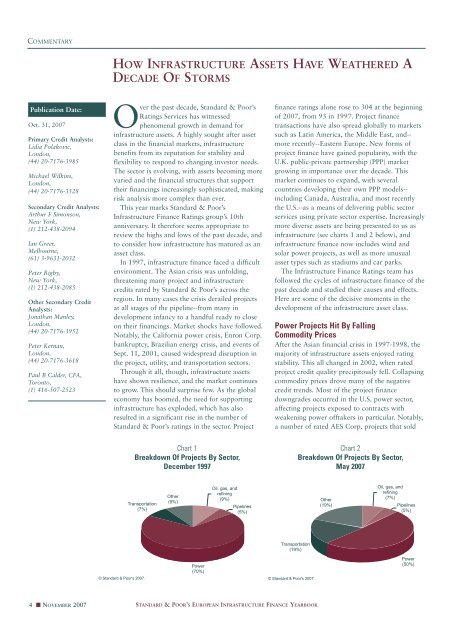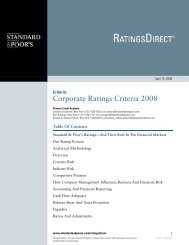European Infrastructure Finance Yearbook - Investing In Bonds ...
European Infrastructure Finance Yearbook - Investing In Bonds ...
European Infrastructure Finance Yearbook - Investing In Bonds ...
You also want an ePaper? Increase the reach of your titles
YUMPU automatically turns print PDFs into web optimized ePapers that Google loves.
COMMENTARY<br />
Publication Date:<br />
Oct. 31, 2007<br />
Primary Credit Analysts:<br />
Lidia Polakovic,<br />
London,<br />
(44) 20-7176-3985<br />
Michael Wilkins,<br />
London,<br />
(44) 20-7176-3528<br />
Secondary Credit Analysts:<br />
Arthur F Simonson,<br />
New York,<br />
(1) 212-438-2094<br />
Ian Greer,<br />
Melbourne,<br />
(61) 3-9631-2032<br />
Peter Rigby,<br />
New York,<br />
(1) 212-438-2085<br />
Other Secondary Credit<br />
Analysts:<br />
Jonathan Manley,<br />
London,<br />
(44) 20-7176-3952<br />
Peter Kernan,<br />
London,<br />
(44) 20-7176-3618<br />
Paul B Calder, CFA,<br />
Toronto,<br />
(1) 416-507-2523<br />
HOW INFRASTRUCTURE ASSETS HAVE WEATHERED A<br />
DECADE OF STORMS<br />
Over the past decade, Standard & Poor’s<br />
Ratings Services has witnessed<br />
phenomenal growth in demand for<br />
infrastructure assets. A highly sought after asset<br />
class in the financial markets, infrastructure<br />
benefits from its reputation for stability and<br />
flexibility to respond to changing investor needs.<br />
The sector is evolving, with assets becoming more<br />
varied and the financial structures that support<br />
their financings increasingly sophisticated, making<br />
risk analysis more complex than ever.<br />
This year marks Standard & Poor’s<br />
<strong><strong>In</strong>frastructure</strong> <strong>Finance</strong> Ratings group’s 10th<br />
anniversary. It therefore seems appropriate to<br />
review the highs and lows of the past decade, and<br />
to consider how infrastructure has matured as an<br />
asset class.<br />
<strong>In</strong> 1997, infrastructure finance faced a difficult<br />
environment. The Asian crisis was unfolding,<br />
threatening many project and infrastructure<br />
credits rated by Standard & Poor’s across the<br />
region. <strong>In</strong> many cases the crisis derailed projects<br />
at all stages of the pipeline--from many in<br />
development infancy to a handful ready to close<br />
on their financings. Market shocks have followed.<br />
Notably, the California power crisis, Enron Corp.<br />
bankruptcy, Brazilian energy crisis, and events of<br />
Sept. 11, 2001, caused widespread disruption in<br />
the project, utility, and transportation sectors.<br />
Through it all, though, infrastructure assets<br />
have shown resilience, and the market continues<br />
to grow. This should surprise few. As the global<br />
economy has boomed, the need for supporting<br />
infrastructure has exploded, which has also<br />
resulted in a significant rise in the number of<br />
Standard & Poor’s ratings in the sector. Project<br />
Chart 1<br />
Breakdown Of Projects By Sector,<br />
December 1997<br />
4 ■ NOVEMBER 2007 STANDARD & POOR’S EUROPEAN INFRASTRUCTURE FINANCE YEARBOOK<br />
finance ratings alone rose to 304 at the beginning<br />
of 2007, from 93 in 1997. Project finance<br />
transactions have also spread globally to markets<br />
such as Latin America, the Middle East, and-more<br />
recently--Eastern Europe. New forms of<br />
project finance have gained popularity, with the<br />
U.K. public-private partnership (PPP) market<br />
growing in importance over the decade. This<br />
market continues to expand, with several<br />
countries developing their own PPP models-including<br />
Canada, Australia, and most recently<br />
the U.S.--as a means of delivering public sector<br />
services using private sector expertise. <strong>In</strong>creasingly<br />
more diverse assets are being presented to us as<br />
infrastructure (see charts 1 and 2 below), and<br />
infrastructure finance now includes wind and<br />
solar power projects, as well as more unusual<br />
asset types such as stadiums and car parks.<br />
The <strong><strong>In</strong>frastructure</strong> <strong>Finance</strong> Ratings team has<br />
followed the cycles of infrastructure finance of the<br />
past decade and studied their causes and effects.<br />
Here are some of the decisive moments in the<br />
development of the infrastructure asset class.<br />
Power Projects Hit By Falling<br />
Commodity Prices<br />
After the Asian financial crisis in 1997-1998, the<br />
majority of infrastructure assets enjoyed rating<br />
stability. This all changed in 2002, when rated<br />
project credit quality precipitously fell. Collapsing<br />
commodity prices drove many of the negative<br />
credit trends. Most of the project finance<br />
downgrades occurred in the U.S. power sector,<br />
affecting projects exposed to contracts with<br />
weakening power offtakers in particular. Notably,<br />
a number of rated AES Corp. projects that sold<br />
Chart 2<br />
Breakdown Of Projects By Sector,<br />
May 2007



